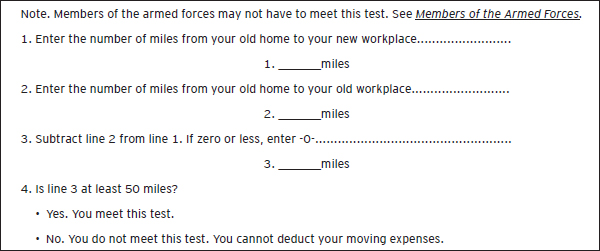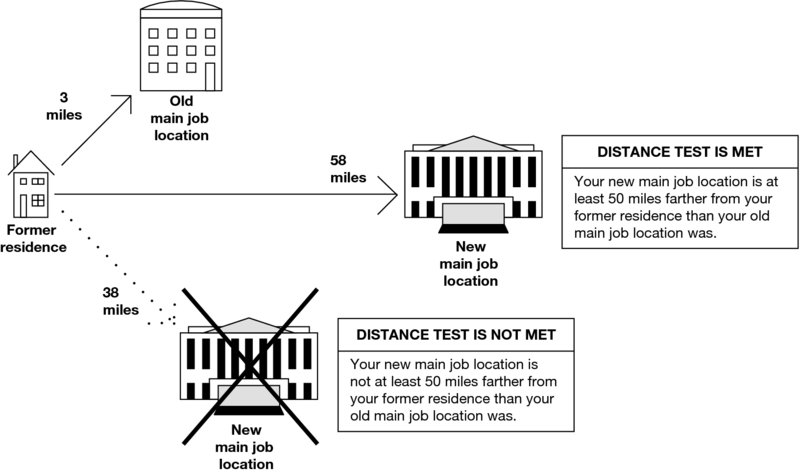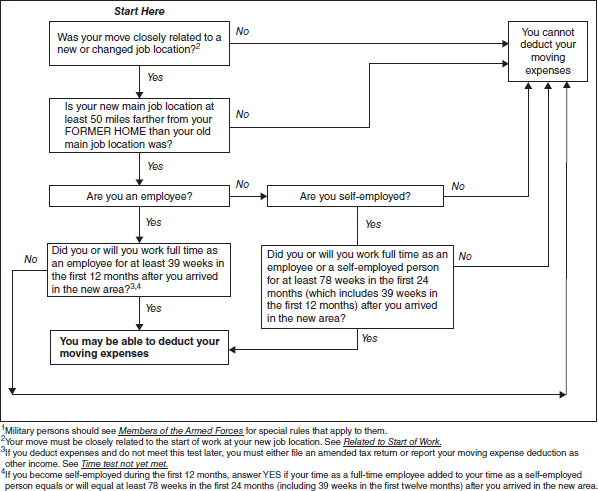Chapter 20
Moving expenses
ey.com/EYTaxGuide
Standard mileage rate. For 2014, the standard mileage rate for the cost of operating your car as part of a deductible move was 23½ cents per mile.
Change of address. If you change your mailing address, be sure to notify the IRS using Form 8822, Change of Address. Mail it to the Internal Revenue Service Center for your old address. Addresses for the Service Centers are on the back of the form.
This chapter explains the deduction of certain expenses of moving to a new home because you changed job locations or started a new job. It includes the following topics.
- Who can deduct moving expenses.
- What moving expenses are deductible.
- What moving expenses are not deductible.
- How a reimbursement affects your moving expense deduction.
- How and when to report moving expenses.
- Special rules for members of the Armed Forces.
You may be able to deduct moving expenses whether you are self-employed or an employee. Your expenses generally must be related to starting work at your new job location. However, certain retirees and survivors may qualify to claim the deduction even though they are not starting work at a new job location. See Who Can Deduct Moving Expenses.
Moves to locations outside the United States. This chapter does not discuss moves outside the United States. If you are a United States citizen or resident alien who moved outside the United States or its possessions because of your job or business, see Publication 521, Moving Expenses, for special rules that apply to your move.
You may want to see:
 521 Moving Expenses
521 Moving Expenses
 3903 Moving Expenses
3903 Moving Expenses
 8822 Change of Address
8822 Change of Address
You can deduct your moving expenses if you meet all three of the following requirements.
- Your move is closely related to the start of work.
- You meet the distance test.
- You meet the time test.
After you have read these rules, see Figure 20-B to help you determine if you can deduct your moving expenses.
Different rules may apply if you are a member of the Armed Forces or a retiree or survivor moving to the United States. These rules are discussed later in this chapter.
Your move must be closely related, both in time and in place, to the start of work at your new job location.
Closely related in time. You can generally consider moving expenses incurred within 1 year from the date you first reported to work at the new location as closely related in time to the start of work. It is not necessary that you arrange to work before moving to a new location, as long as you actually do go to work.
If you do not move within 1 year of the date you begin work, you ordinarily cannot deduct the expenses unless you can show that circumstances existed that prevented the move within that time frame.
Example. Your family moved more than a year after you started work at a new location. You delayed the move for 18 months to allow your child to complete high school. You can deduct your moving expenses. This is an exception to the rule listed above.
Closely related in place. You can generally consider your move closely related in place to the start of work if the distance from your new home to the new job location is not more than the distance from your former home to the new job location. If your move does not meet this requirement, you may still be able to deduct moving expenses if you can show that:
- You are required to live at your new home as a condition of your employment, or
- You will spend less time or money commuting from your new home to your new job location.
Home defined. Your home means your main home (residence). It can be a house, apartment, condominium, houseboat, house trailer, or similar dwelling. It does not include other homes owned or kept up by you or members of your family. It also does not include a seasonal home, such as a summer beach cottage. Your former home means your home before you left for your new job location. Your new home means your home within the area of your new job location.
Retirees or survivors. You may be able to deduct the expenses of moving to the United States or its possessions even though the move is not related to the start of work at a new job location. You must have worked outside the United States or be a survivor of someone who did. See Retirees or Survivors Who Move to the United States, later.
Your move will meet the distance test if your new main job location is at least 50 miles farther from your former home than your old main job location was from your former home. For example, if your old main job location was 3 miles from your former home, your new main job location must be at least 53 miles from that former home. See Worksheet 20-1 to determine if you meet this test.
The distance between a job location and your home is the shortest of the more commonly traveled routes between the two. The distance test considers only the location of your former home. It does not take into account the location of your new home. See Figure 20-A.
Example. You moved to a new home less than 50 miles from your former home because you changed main job locations. Your old main job location was 3 miles from your former home. Your new main job location is 60 miles from that home. Because your new main job location is 57 miles farther from your former home than the distance from your former home to your old main job location, you meet the distance test.
Worksheet 20-1. Distance Test


Figure 20-A. Illustration of Distance Test
First job or return to full-time work. If you go to work full time for the first time, your place of work must be at least 50 miles from your former home to meet the distance test.
If you go back to full-time work after a substantial period of part-time work or unemployment, your place of work must also be at least 50 miles from your former home.
Armed Forces. If you are in the Armed Forces and you moved because of a permanent change of station, you are not required to meet the distance test. See Members of the Armed Forces, later.
Main job location. Your main job location is usually the place where you spend most of your working time. If there is no one place where you spend most of your working time, your main job location is the place where your work is centered, such as where you report for work or are otherwise required to “base” your work.
Union members. If you work for several employers on a short-term basis and you get work under a union hall system (such as a construction or building trades worker), your main job location is the union hall.
More than one job. If you have more than one job at any time, your main job location depends on the facts in each case. The more important factors to be considered are:
- The total time you spend at each place,
- The amount of work you do at each place, and
- How much money you earn at each place.
To deduct your moving expenses, you also must meet one of the following two time tests.
- The time test for employees.
- The time test for self-employed persons.
Both of these tests are explained below. See Table 20-1 for a summary of these tests.
If you are an employee, you must work full time for at least 39 weeks during the first 12 months (39-week test) after you arrive in the general area of your new job location. Full-time employment depends on what is usual for the type of work you perform in your area.
For purposes of this test, the following four rules apply.
- You count only your full-time work as an employee, not any work you do as a self-employed person.
- You do not have to work for the same employer for all 39 weeks.
- You do not have to work 39 weeks in a row.
- You must work full time within the same general commuting area for all 39 weeks.
Table 20-1. Satisfying the Time Test for Employees and Self-Employed Persons
IF you are… |
THEN you satisfy the time test by meeting the… |
an employee |
39-week test for employees. |
both self-employed and an employee, but unable to satisfy the 39-week test for employees |
78-week test for self-employed persons. |
both self-employed and an employee at the same time |
78-week test for self-employed persons or the 39-week test for an employee. Your principal place of work determines which test applies. |
self-employed |
78-week test for self-employed persons. |

 521 Moving Expenses
521 Moving Expenses  3903 Moving Expenses
3903 Moving Expenses 8822 Change of Address
8822 Change of Address 
